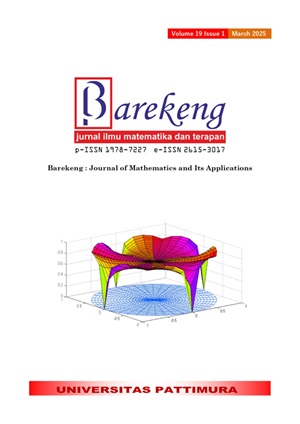DEVELOPMENT OF NONPARAMETRIC PATH FUNCTION USING HYBRID TRUNCATED SPLINE AND KERNEL FOR MODELING WASTE-TO-ECONOMIC VALUE BEHAVIOR
Abstract
Waste management remains a challenge, including in Batu City, East Java, Indonesia. Rapid population growth and economic activities in the city have resulted in a substantial increase in waste volume. One of the key factors in solving waste problems is the mindset of the community towards waste management. The application of statistical analysis methods can be an effective approach to solving problems related to waste management from an economic point of view. Nonparametric path analysis is a statistical method that does not rely on the assumption that the curve is known. Nonparametric path analysis is performed if the data does not fulfill the linearity assumption. This study aims to determine the best nonparametric path function with a hybrid truncated spline and kernel approach among EV values of 0.5; 0.8; and 1. In addition, this study also aims to test the significance of the best path function obtained. The data used in this study are timer data obtained from the Featured Basic Research Grant. The results showed that the best model of hybrid truncated spline and kernel nonparametric path analysis is a hybrid model of truncated spline nonparametric path of linear polynomial degree 1 knot and kernel triangle nonparametric path at EV 0.5. In addition, the significance of the best nonparametric truncated spline and kernel hybrid path function estimation using jackknife resampling shows that all exogenous variables have a significant effect on endogenous variables as evidenced by a p-value smaller than (0.05).
Downloads
References
Solimun, A. A. R. Fernandes, and Nurjannah, Metode statistika multivariat pemodelan persamaan struktural (SEM) pendekatan WarpPLS. UB Press, 2017.
A. A. R. Fernandes, “Analisis Regresi dalam Pendekatan Fleksibel: Ilustrasi dengan Paket Program R.” books.google.com, 2021. [Online]. Available: https://books.google.com/books?hl=en&lr=&id=SKFgEAAAQBAJ&oi=fnd&pg=PP1&dq=%22analisis+jalur+nonparametrik%22&ots=r9WFnTCaTN&sig=6dtEyD8x1eICSO9hW71bcP-YlAA
I. Sriliana, I. N. Budiantara, and V. Ratnasari, “The performance of mixed truncated spline-local linear nonparametric regression model for longitudinal data,” MethodsX, vol. 12, p. 102652, Jun. 2024, doi: 10.1016/j.mex.2024.102652.
P. O. Adekola et al., “Public perception and awareness of waste management from Benin City,” Sci Rep, vol. 11, no. 1, p. 306, Jan. 2021, doi: 10.1038/s41598-020-79688-y.
S. Y. Abbas, K. Kirwan, and D. Lu, “Measuring the Public Awareness toward Household Waste Management in Muharraq Governorate-Kingdom of Bahrain,” JEP, vol. 11, no. 03, pp. 196–214, 2020, doi: 10.4236/jep.2020.113012.
M. Gharfalkar, R. Court, C. Campbell, Z. Ali, and G. Hillier, “Analysis of waste hierarchy in the European waste directive 2008/98/EC,” Waste Management, vol. 39, pp. 305–313, May 2015, doi: 10.1016/j.wasman.2015.02.007.
D. N. Kusumaningrum and P. P. Haffsari, “GOOD GOVERNANCE FOR SUSTAINABLE DEVELOPMENT: MUNICIPAL WASTE MANAGEMENT,” 2017.
A. Iriany and A. A. R. Fernandes, “Hybrid Fourier series and smoothing spline path non-parametrics estimation model,” Front. Appl. Math. Stat., vol. 8, p. 1045098, Jan. 2023, doi: 10.3389/fams.2022.1045098.
Suparti, A. Prahutama, and R. Santoso, “Mix local polynomial and spline truncated: the development of nonparametric regression model,” J. Phys.: Conf. Ser., vol. 1025, p. 012102, May 2018, doi: 10.1088/1742-6596/1025/1/012102.
A. A. R. Fernandes and Solimun, Analisis Regresi dalam Pendekatan Fleksibel: Ilustrasi dengan Paket Program R. Universitas Brawijaya Press, 2021.
F. Ubaidillah, A. A. R. Fernandes, A. Iriany, N. W. S. Wardhani, and S. Solimun, “Truncated Spline Path Analysis Modeling on in Company X with the Governments Role as a Mediation Variable,” J. Stat. Appl. Pro., vol. 11, no. 3, pp. 781–794, Sep. 2022, doi: 10.18576/jsap/110303.
E. C. L. Efendi, A. A. R. Fernandes, and M. B. T. Mitakda, “Modeling of Path Nonparametric Truncated Spline Linear, Quadratic, and Cubic in Model on Time Paying Bank Credit,” ms, vol. 9, no. 6, pp. 947–957, Nov. 2021, doi: 10.13189/ms.2021.090611.
M. D. Cattaneo, M. Jansson, and X. Ma, “Simple Local Polynomial Density Estimators,” Jun. 07, 2019, arXiv: arXiv:1811.11512. Accessed: Aug. 07, 2024. [Online]. Available: http://arxiv.org/abs/1811.11512
M. D. Faridza, “SELECTION OF THE BEST B-SPLINE REGRESSION MODEL FOR ESTIMATING BITCOIN PRICE INCREASES BASED ON ORDER AND OPTIMAL KNOT POINT,” Orics, vol. 4, no. 3, pp. 81–86, Sep. 2023, doi: 10.47194/orics.v4i3.248.
D. LaFontaine, “The History of Bootstrapping: Tracing the Development of Resampling with Replacement,” The Mathematics Enthusiast, vol. 18, no. 1–2, pp. 78–99, Jan. 2021, doi: 10.54870/1551-3440.1515.
I. Rodliyah, “PERBANDINGAN METODE BOOTSTRAP DAN JACKKNIFE DALAM MENGESTIMASI PARAMETER REGRESI LINIER BERGANDA,” jmpm. jurnal. matematika. dan. pendidik. matematika., vol. 1, no. 1, p. 76, Mar. 2016, doi: 10.26594/jmpm.v1i1.516.
W. Suryadi and E. D. Supandi, “Membangun Interval Kepercayaan Proporsi dengan Menggunakan Metode Jackknife Sampel Terhapus-,” vol. 19, no. 1, 2019.
A. Iriany, H. R. A. Putri, and A. J. Yuwanto, “ESTIMATION OF PATH ANALYSIS WITH JACKKNIFE AND BLINDFOLD RESAMPLING APPROACH,” . Vol., no. 23, 2022.
Copyright (c) 2025 Usriatur Rohma, Adji Achmad Rinaldo Fernandes, Suci Astutik, Solimun Solimun

This work is licensed under a Creative Commons Attribution-ShareAlike 4.0 International License.
Authors who publish with this Journal agree to the following terms:
- Author retain copyright and grant the journal right of first publication with the work simultaneously licensed under a creative commons attribution license that allow others to share the work within an acknowledgement of the work’s authorship and initial publication of this journal.
- Authors are able to enter into separate, additional contractual arrangement for the non-exclusive distribution of the journal’s published version of the work (e.g. acknowledgement of its initial publication in this journal).
- Authors are permitted and encouraged to post their work online (e.g. in institutional repositories or on their websites) prior to and during the submission process, as it can lead to productive exchanges, as well as earlier and greater citation of published works.






1.gif)



